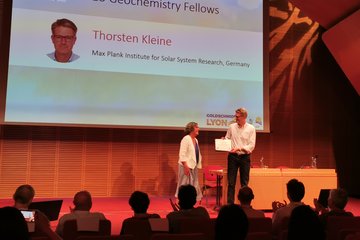Alle Typen
141.
Zeitschriftenartikel
A stream of particles from the β Pictoris disc: A possible ejection mechanism. Astronomy and Astrophysics 402, S. L5 - L8 (2003)
142.
Zeitschriftenartikel
Reconstruction of solar irradiance variations in Cycle 23: Is solar surface magnetism the cause? Astronomy and Astrophysics 399, S. L1 - L4 (2003)
143.
Zeitschriftenartikel
Can solar variability explain global warming since 1970? Journal Geophysical Research 108 (A5), 1200 (2003)
144.
Zeitschriftenartikel
The 1.3-year and 156-day periodicities in sunspot data: wavelet analysis suggests a common origin. Astronomy and Astrophysics 394, S. 701 - 706 (2002)
145.
Zeitschriftenartikel
Was one sunspot cycle in the 18th century really lost? Astronomy and Astrophysics 396, S. 235 - 242 (2002)
146.
Zeitschriftenartikel
Search for a relationship between solar cycle amplitude and length. Astronomy and Astrophysics 396, S. 1029 - 1035 (2002)
147.
Zeitschriftenartikel
Porous Dust Grains in the Shells of Herbig Ae/Be Stars. Astron. Lett. 26, S. 379 (2000)
148.
Zeitschriftenartikel
Size distribution of dust in circumstellar debris disks. Astronomy and Astrophysics 362, S. 1127 - 1137 (2000)
149.
Zeitschriftenartikel
Dust around Herbig Ae/Be Stars: Porous, Cometery - like Grains? Icarus 143, S. 159 - 169 (2000)
150.
Zeitschriftenartikel
The disk of (- pictoris in the light of polarimetric data. Astrophysical Journal 539, S. 424 - 434 (2000)
151.
Zeitschriftenartikel
WWW database of optical constants for astronomy. Astronomy and Astrophysics, Suppl. Ser. 136, S. 405 - 406 (1999)
152.
Zeitschriftenartikel
Dust around Herbig Ae/Be stars: modelling of observational data. Earth Planets Space 50, S. 603 - 606 (1998)
153.
Buchkapitel
Models of Solar Total and Spectral Irradiance Variability of Relevance for Climate Studies. In: Climate and Weather of the Sun-Earth System (CAWSES), S. 19 - 38 (Hg. Lübken, F.-J.). Springer, Dordrecht (2013)
154.
Buchkapitel
Climate and Weather of the Sun-Earth System, in Astronomy and Astrophysics. In: Encyclopedia of Life Support Systems (EOLSS) (Hg. Engvold, O.; Stabell, R.; Czerny, B.; Lattanzio, J.). Eolss Publishers, Oxford, UK (2011)
155.
Buchkapitel
11-year solar cycle. In: Astronomy, Astrophysics, and Cosmology, S. 97 - 108 (Hg. Trümper, J.). Springer, Berlin (2009)
156.
Buchkapitel
Sunspots. In: Astronomy, Astrophysics, and Cosmology, S. 109 - 118 (Hg. Trümper, J.). Springer, Berlin (2009)
157.
Buchkapitel
Faculae and plage. In: Astronomy, Astrophysics, and Cosmology, S. 119 - 126 (Hg. Trümper, J.). Springer, Berlin (2009)
158.
Buchkapitel
Polarization of the Zodiacal Cloud and Other Solar System-type Debris Disks. In: Meteoroids 1998, Proc. Int. Conf. held at Tatranská Lomnica, Slovakia, August 17-21, 1998, S. 291 - 294 (Hg. Baggaley, W. J.; Porubcan, V.). Astronomical Inst., Slovak Acad. Sci., Bratislava (1999)
159.
Konferenzbeitrag
Semi-empirical Long-term Reconstruction of the Heliospheric Parameters: Validation by Cosmogenic Radionuclide Records. Publications of the astronomical society of the pacific 504, S. 269 - 272 (2016)
160.
Konferenzbeitrag
Commission 12: Solar Radiation and Structure. Transactions of the IAU 29A, S. 278 - 299 (2016)











